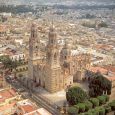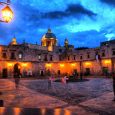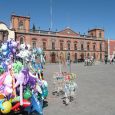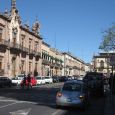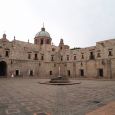Morelia
Advertisement
By plane
Morelia has a relatively new, modern airport at the edge of town. An authorized taxi into the city in 2010 cost US$3.50 (2006) for up to 4 passengers and suitcases that fit inside the trunk. Going to the city center takes about a half hour. Book the taxi within the terminal and take the ticket to the taxi area.
There are daily International flights from LAX, IAH and ORD and scheduled flights from SFO, SJC, SFM, which lead to MLM, Morelia's international airport, as do commuter flights from GDL, MEX, BJX and TIJ.
By car
Morelia is accessible by a modern toll road, and is located equidistant from Guadalajara and Mexico City. There are plenty of newer Pemex stations along the way, with restrooms and food. Be prepared with change/pesos to pay tolls. It is a very scenic trip, to say the least.
By bus
Deluxe buses serve Morelia from all parts of the Republic, and Morelia's state-of-the-art bus station, located in the northern part of the city. The bus station consists of separate terminals for first-class and second-class buses. It is easy to reach Morelia from either Mexico City or Guadalajara. The bus trip from Guadalajara is about 3-1/2 hours. From Mexico City, depending on the company, the trip can take up to six hours. You can also reach Morelia from the United States by way of Greyhound
Advertisement
The Casa de la Cultura
The Casa de la Cultura is also the home of the Instituto Michoacano de Cultura and the State Secretary of Culture. It is in the former monastery of Nuestra Señora del Carmen Descalzo, which was established in 1593. The church building was probably finished in 1619, the date inscribed on the south portal, but monastery construction continued into the 17th century. In the 19th century, the Reform Laws expropriated the cloisters and living quarters but left the church to its religious function, which continues to this day.
Cathedral
The first church on the Cathedral site was built in 1577, which was a modest structure of adobe and wood. Many years later, this structure would be almost completely destroyed by a fire.[3] Originally, the Cathedral of Michoacán was in Pátzcuaro in a church that now is the Basilica of Nuestra Señora de la Salud. When cathedral status was moved from there to Valladolid in 1580, the city became the civil, religious and cultural capital of the territory
Regional Museum of Michoacan
The Museo Regional Michoacano (Regional Museum of Michoacan) was founded in 1886 and its design was heavily influenced by French ideas of museum design of the time. It is housed in a building that belonged to Emperor Maximilian I, and is of ornate Baroque design. Most of the exhibits are about the history of the region with rooms dedicated to pre-Hispanic artifacts and colonial art. One noted piece is the painting called “Traslado de las Monjas” which is considered to be the finest work produced in Michoacán during the colonial period. Other important works include the original volume of the Voyage de Humboldt et Bonpland, edited in Paris in 1807 and the murals done by Alfredo Zalce, Federico Cantú and Grace Greenwood. There are also interactive exhibits on the origins of the earth and life. The museum also has conference rooms, a library and a reading room
Jose Maria Morelos y Pavon House Museum
The Casa Museum Jose Maria Morelos y Pavon (Jose Maria Morelos y Pavon House Museum) contains a collection of items from the colonial and early independence periods of Mexico’s history, including articles that belonged to Morelos himself. Morelos bought the house in 1802, but did not live there much, especially in the years just before and during the Mexican War of Independence because of his involvement with the movement. In 1933, the house was declared a national monument and in 1939 became the property of INAH to be converted into this museum. Later, the building underwent another round of restoration work and was re-inaugurated in 1991. The lower level is mostly dedicated to Morelos with the rooms on the upper level dedicated to the war in general. The museum is also the archive of the Bishopric of Michoacán and contains documents from the 16th to the 20th century.
Morelos’ Birthplace
The Casa Natal de Morelos (Morelos’ Birthplace) is the house where José María Morelos y Pavón was born in 1765. The building is a large mansion with a Neoclassic facade and a Baroque interior. In 1888, the original building was destroyed to build a farmhouse. This is the building that has been restored and turned into a museum in 1964, for the coming bicentennial of Morelos’ birth. The museum contains documents and belongings of Morelos including ones he signed, money he had coined, paintings and a large library
Mask Museum
The Museo de la Mascara (Mask Museum) presents two different mask collections, totaling more than 165 examples from cultures in twenty Mexican states. It is located in the Casa de Artesanias de Morelia (Handcraft House of Morelia).
The State Museum
The Museo del Estado (The State Museum) is dedicated to the state’s past and present. It was opened in 1986 and divided into three sections – archeology, history and ethnology of the state. There is also an exhibit of the old Mier Pharmacy with its equipment from 1868. The museum is amansion dating from the 18th century
Information not available
Information not available
Advertisement

